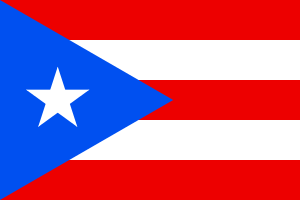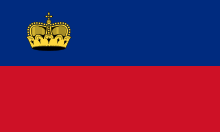Flag of the Philippines
 | |
| Name |
Tatlong Bituin at Isang Araw ("Three Stars and a Sun") Pambansang Watawat ("National Flag") |
|---|---|
| Use |
National flag and ensign |
| Proportion | 1:2 |
| Adopted |
June 12, 1898 (original version used by the First Philippine Republic) February 12, 1998 (current version reaffirmed by Republic Act No. 8491) |
| Design | A horizontal bicolour of blue and red; with a white equilateral triangle based at the hoist containing three, 5-pointed gold stars at its vertices, and an 8-rayed gold sun at its center.[lower-alpha 1] |
| Designed by | Emilio Aguinaldo |
|
Variant flag of the Philippines | |
| Use |
State and war flag |
| Proportion | 1:2 |
| Design | As above, with the blue and red stripes switched to indicate a state of war. |
| Designed by | Executive Order No. 321 of Elpidio Quirino and Executive Order No. 23 of Manuel L. Quezon in 1936 |
The National Flag of the Philippines (Filipino: Pambansang Watawat ng Pilipinas), also called the Three Stars and a Sun (Tatlong Bituin at Isang Araw), is a horizontal flag bicolor with equal bands of royal blue and scarlet, and with a white, equilateral triangle at the hoist. In the center of the triangle is a golden-yellow sun with eight primary rays, each representing a Philippine province.[lower-alpha 1] At each vertex of the triangle is a five-pointed, golden-yellow star, each of which representing one of the country's three main island groups—Luzon, Visayas, and Mindanao, the central star originally referred to Panay (where Iloilo is located, the first province outside Luzon to have raised this flag) which is commonly mistaken to be the whole island group of Visayas. Panay, which recent interpretations call as "as representative of the entire Visayas region".[7][11]
A unique feature of this flag is its ability to indicate a state of war if it is displayed with the red side on top.[12]
Design
Construction
The flag's length is twice its width, giving it an aspect ratio of 1:2. The length of all the sides of the white triangle are equal to the width of the flag. Each star is oriented in such manner that one of its tips points towards the vertex at which it is located.[13] Moreover, the gap-angle between two neighbours of the 8 ray-bundles is as large as the angle of one ray-bundle (so 22.5°), with each major ray having double the thickness of its two minor rays.[14] The golden sun is not exactly in the center of the triangle but shifted slightly to the right. This flag is waved when having ceremonies[15]
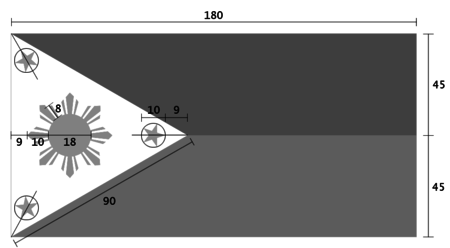
Color
The shade of blue used in the flag has varied over time, beginning with the original color lazuli Rosco. The exact nature of this shade is uncertain, but a likely candidate is the blue of the Cuban flag, which a theory says influenced the flag's design. Specifications for the flag's colors with shades matching those used in the American flag were adopted by the National Historical Institute in 1955. President Ferdinand Marcos ordered the colors restored to the original light blue and red of the Cuban flag in 1985, but this was immediately rescinded after the 1986 People Power Revolution that removed him from power. For the 1998 independence centennial celebrations, the Flag and Heraldic Code of the Philippines (RA 8491) was passed, designating royal blue as the official variant.[16]
The flag's colors are specified by Republic Act 8491 in terms of their cable number in the system developed by the Color Association of the United States.[13][17] The official colors and their approximations in other color spaces are listed below:.[18]
| Scheme | Blue | Red | White | Yellow |
|---|---|---|---|---|
| Cable No. | 80173 | 80108 | 80001 | 80068 |
| Pantone | 286 | 186 | N/A | 116 |
| RGB | 0-56-168 | 206-17-38 | 255-255-255 | 252-209-22 |
| CMYK | C100-M60-Y0-K5 | C0-M90-Y65-K10 | N/A | C0-M18-Y85-K0 |
| HEX | #0038A8 | #CE1126 | #FFFFFF | #FCD116 |
Usage as war ensign
The Philippines does not utilize a separate war flag; instead, the national flag itself is used for this purpose.[13] To indicate a state of war, the red field is flown upwards and is placed on the right (on the observer's left) if it is in a hanging position. In times of peace, however, the blue area is the superior field.[19][20] The orientation of the flag was used during the Philippine–American War from 1899 to 1901,[21] World War II by the Philippine Commonwealth from 1941 to 1945 and by the Japanese-sponsored Philippine Republic when it declared war against the United Kingdom and the United States in 1944,[22] the coup attempts during President Corazon Aquino's administration, and EDSA III.[23] The only time that the flag was not oriented in a state of war was during the Battle of Alapan in 1898, 15 days before the Philippine Declaration of Independence in Kawit, Cavite.
During the 2010 US-Association of Southeast Asian Nations (ASEAN) summit in New York City, the Philippine flag was inadvertently flown with the red field on top. The U.S. Embassy in Manila apologized for the mistake, and the Philippines Department of Foreign Affairs accepted the apology.[12]
Symbolism
|
The Philippine national flag has a rectangular design that consists of a white equilateral triangle, symbolizing liberty, equality, and fraternity; a horizontal blue stripe for peace, truth, and justice; and a horizontal red stripe for patriotism and valor. In the center of the white triangle is an eight-rayed golden sun symbolizing unity, freedom, people's democracy, and sovereignty. Each ray represents a province with significant involvement in the 1896 Philippine Revolution against Spain; these provinces are Manila, Bulacan, Cavite, Pampanga, Tarlac, Laguna, Batangas, and Nueva Ecija.[8][lower-alpha 1] Three five-pointed stars, one for each of the triangle's points, stand for the three major islands where the revolution started: Luzon, Visayas and Mindanao.
The flag's original symbolism is enumerated in the text of the independence proclamation, which makes reference to an attached drawing, though no record of the drawing has surfaced.[24] The proclamation explains the flag as follows:
“ And finally it was resolved unanimously that this Nation, already independent from today should use the same flag which it has used, whose shape and colors are described in the attached drawing rendering realistically the three aforementioned forces representing the white triangle as the distinctive symbol of the famed Society of the Katipunan, which through the blood compact impelled the masses to rise in revolt; the three stars representing the three principal islands of this Archipelago — Luzon, Mindanao, and Panay (Visayas) in which the revolutionary movement broke out; the sun indicating the gigantic steps taken by the children of this country on the road to progress and civilization; the eight rays symbolizing the eight provinces of the Philippines,[lower-alpha 1] and the colors of blue, red and white commemorating the flag of the United States of North America as a manifestation of our profound gratitude towards this Great Nation for its disinterested protection which it lends us, and continues to lend us. And, carrying this flag, I unfurl it before the gentlemen assembled here—[List of names of the delegates]—and we all solemnly swear to acknowledge and defend it to the last drop of our blood. ”
The symbolism given in the 1898 Proclamation of Philippine Independence differs from the current official explanation. According to the document the white triangle signifies the emblem of the Katipunan, the secret society that opposed Spanish rule. It says the flag's colors commemorate the flag of the United States as a manifestation of gratitude for American aid against the Spanish during the Philippine Revolution. It also says that one of the three stars represents the island of Panay, rather than the entire Visayan islands. The proclamation also declares that the sun represents the gigantic steps made by the sons of the country along the path of Progress and Civilization, and lists Bataan instead of Tarlac among the eight provinces symbolized by the sun's rays.
History
Historical flags of the Philippine Revolution
It has been common since the 1960s to trace the development of the Philippine flag to the various war standards of the individual leaders of the Katipunan, a pseudo-masonic revolutionary movement that opposed Spanish rule in the Philippines and led the Philippine Revolution.[24] However, while some symbols common to the Katipunan flags would be adopted into the iconography of the Revolution, it is inconclusive whether these war standards can be considered precursors to the present Philippine flag.[24]
-

The first flag of the Katipunan.
-
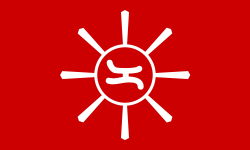
Flag of the Magdalo Katipunan faction.
-
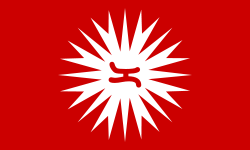
Flag of the Magdiwang Katipunan faction.
-

The flag adopted by the Republic of Biak-na-Bato in 1897.
The first flag of the Katipunan was a red rectangular flag with a horizontal alignment of three white Ks (an acronym for the Katipunan's full name, Kataas-taasang Kagalang-galangang Katipunan ng mga Anak ng Bayan - Supreme and Venerable Society of the Sons of the Nation). The flag's red field symbolized blood, as members of the Katipunan signed their membership papers in their own blood.[24]
The various leaders of the Katipunan, such as Andrés Bonifacio, Mariano Llanera, and Pío del Pilar, also had individual war standards. The organization was represented in Cavite province by two factions: the Magdiwang faction and the Magdalo faction, with each adopting a flag. Both used a white sun. Instead of the letter K the flags bore the symbol for the syllable ka in Baybayin, the pre-Hispanic writing script of the Tagalogs.
The Katipunan adopted a new flag in 1897 during an assembly at Naic, Cavite. This new flag was red and depicted a white sun with a face. The sun had eight rays, representing eight provinces of the Philippines.[lower-alpha 1]
Current flag
The earlier design of the current Philippine flag was conceptualized by Emilio Aguinaldo during his exile in Hong Kong in 1897. The first flag was sewn by Marcela Marino de Agoncillo with the help of her daughter Lorenza and Delfina Herbosa de Natividad (a niece of Propagandista José Rizal). It was first displayed in Battle of Alapan on May 28, 1898.
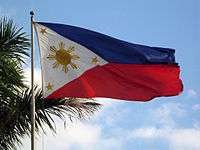
The flag was formally unfurled during the proclamation of independence on June 12, 1898 in Kawit, Cavite.[25] However, a Manila Times article by Augusto de Viana, Chief History Researcher, National Historical Institute, mentions assertions in history textbooks and commemorative rites that the flag was first raised in Alapan, Imus, Cavite, on May 28, 1898, citing Presidential Proclamation No. 374, issued by then-President Diosdado Macapagal on March 6, 1965.[26] The article goes on to claim that historical records indicate that the first display of the Philippine flag took place in Cavite City, when General Aguinaldo displayed it during the first fight of the Philippine Revolution.
The original design of the flag adopted a mythical sun with a face influenced by Latin American republics Argentina, Peru, and Uruguay; a triangle, representing the Katipunan which inspired by the Eye of Providence in the Great Seal of the United States and the Masonic Triangle and which enshrined Liberté, Égalité, Fraternité; the stripes and colors derived from the American flag. The particular shade of blue of the original flag has been a source of controversy. Based on anecdotal evidence and the few surviving flags from the era, historians argue that the colors of the original flag was influenced by flag of Cuba and flag of Puerto Rico.[24]
The original flag that was first hoisted on May 28, 1898 and unfurled during Declaration of independence on June 12, 1898, was currently being preserved at the Gen Emilio Aguinaldo Museum in Baguio City. There are plans to restore the flag by replacing of the worn-out portion of the flag, but they could not find the right type of threads to match those used by the tailors, so the idea was abandoned. The flag is more elaborate than the flag which now currently in used. It bears embroidered words, Libertad, Justicia and Ygualidad (Liberty, Justice and Equality) on one side of the flag and Fuerzas Expedicionarias del Norte de Luzon (Expeditionary forces of Northern Luzon) on the other[27]
Hostilities broke out between the Philippines and the United States in 1899. The flag was first flown with the red field up on February 4, 1899 to show that a state of war existed. Aguinaldo was captured by the Americans two years later, and swore allegiance to the United States.
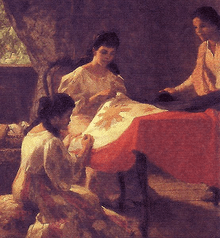
With the defeat of the Philippine Republic, the Philippines was placed under American colonial rule and the display of the Philippine flag was declared illegal by the Sedition Act of 1907. This law was repealed on October 24, 1919.[28] With the legalization of display of the Philippine flag, the cloth available in most stores was the red and blue of the flag of the United States, so the flag from 1919 onwards adopted the "National Flag blue" color. On March 26, 1920, the Philippine Legislature passed Act. No 2928 on March 26, 1920, which legally adopted the Philippine flag as the official flag of the Philippine Islands.[28] Up until the eve of World War II, Flag Day was celebrated on annually on October 30, commemorating the date the ban on the flag was lifted.
The Commonwealth of the Philippines was inaugurated in 1935. On March 25, 1936, President Manuel L. Quezon issued Executive Order No. 23 which provided for the technical description and specifications of the flag.[24] Among the provisions of the order was the definition of the triangle at the hoist as an equilateral triangle, the definition of the aspect ratio at 1:2, the precise angles of the stars, the geometric and aesthetic design of the sun, and the formal elimination of the mythical face on the sun. The exact shades of colors, however, were not precisely defined. These specifications have remained unchanged and in effect to the present. In 1941, Flag Day was officially moved to June 12, commemorating the date that Philippine independence was proclaimed in 1898.
The flag was once again banned with the Japanese invasion and occupation of the Philippines beginning December 1941, to be hoisted again with the establishment of the Second Republic of the Philippines, a client state of Japan. In ceremonies held in October 1943, Emilio Aguinaldo hoisted the flag with the original Cuban blue and red colors restored. The flag was initially flown with the blue stripe up, until President José P. Laurel proclaimed the existence of a state of war with the Allied Powers in 1944. The Commonwealth government-in-exile in Washington, D.C. continued to use the flag with the American colors, and had flown it with the red stripe up since the initial invasion of the Japanese. With the combined forces of the Filipino & American soldiers and the liberation of the Philippines in 1944 to 1945, the flag with the American colors was restored, and it was this flag that was hoisted upon the granting of Philippine independence from the United States on July 4, 1946.
Chronology
| Flag | Date | Use | Description |
|---|---|---|---|
| The Spanish East Indies (1565–1898) | |||
 | 1565–1730 | Flag used when the Philippine Islands were a part of New Spain. | The Cross of Burgundy: a red saltire resembling two crossed, roughly-pruned branches, on a white field. |
 | 1730–1761 | Used during Spanish East Indies period. | Flag of Spain under the reign of King Philip V |
 | 1761–1785 | Used during Spanish East Indies period. | Flag of Spain under the reign of King Felipe V's grandson, King Carlos III |
.svg.png) | 1762–1764 | Flag during the British occupation of the Philippines, as used in occupied Manila and Cavite. | The flag of the British East India Company before 1810: A flag with red and white stripes with the Kingdom of Great Britain's Union Flag as a canton. The Union flag bears red cross on a white field, commonly called St George's Cross, superimposed on a white saltire on a blue field, known as St Andrew's Cross. Also known as the "King's Colours". |
.svg.png) | 1785–1873 | Used during Spanish East Indies period. | Three horizontal stripes of red, weld-yellow and red, the centre stripe being twice as wide as each red stripe with arms in the first third of the weld-yellow stripe. The arms are crowned and vertically divided, the left red field with a tower representing Castille, the right white field with a lion representing León. |
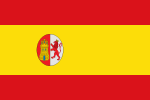 | 1873–1874 | Used by the Spanish East Indies under the First Spanish Republic. | Three horizontal stripes: red, weld-yellow and red, the yellow strip being twice as wide as each red stripe with arms in the first third of the yellow stripe. Royal crown removed from arms. |
.svg.png) | 1874–1898 | Used during Spanish East Indies after the restoration of the Spanish monarchy. | The flag of the Kingdom of Spain used prior to the First Spanish Republic was reinstated. |
| Philippine Revolution – First Philippine Republic | |||
 | 1897–1898 | First official flag of the Philippine republic and used during the Philippine Revolution. | The flag was created in Naic, Cavite and first displayed in 1897. It features an eight-rayed white sun with a mythical face on a field of red. |
.svg.png) | 1898–1901 | The Three Stars and a Sun design was conceived by President Emilio Aguinaldo. The exact shade of blue is debated; three variants were used by subsequent governments. | Sewn by Marcela Marino de Agoncillo, Lorenza Agoncillo, and Delfina Herbosa de Natividad in Hong Kong and first flown in battle on May 28, 1898. It was formally unfurled during the Proclamation of Philippine Independence and the flag of the First Philippine Republic, on June 12, 1898 by President Aguinaldo. It contains a mythical sun (with a face) similar to the Sun of May in other former Spanish colonies; the triangle of Freemasonry; the eight rays representing eight rebellious provinces of the Philippines first placed under martial law by the Governor-General.[lower-alpha 1]. The flag has the words Fuerzas Expeditionarias del Norte de Luzon on its obverse and Libertad Justicia e Ygualdad on its reverse. |
| American and Commonwealth Period (1898–1946) | |||
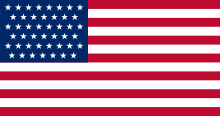 | 1898–1908 | Used while under direct administration from the United States of America. | The Philippine Commission, passed Act No. 1697 or the Flag Law of 1907, which outlawed the display of the Philippine flag and replaced the country's flag to the stars and stripes of the United States of America. The same law prohibited the playing of the national anthem. Thirteen horizontal stripes of alternating red and white representing the original Thirteen Colonies; in the canton, white stars on a blue field, the number of stars increased as the United States expanded its territory. |
 | 1908–1912 | Variant after Oklahoma became a state | |
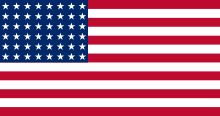 | 1912–1919 | Variant after Arizona and New Mexico achieved statehood | |
 | 1919–1936 | From October 30, 1919,[29] two flags were flown in the Philippines, the American flag and the flag conceived by Emilio Aguinaldo which was made the national flag of the Philippines with the repealing of Act No. 1697.[30] | The American flag remained unchanged since 1919. For the Philippine flag, the design conceived by Emilio Aguinaldo remained but the shades of blue and red were adopted from the American flag. The sun's face was removed, but its stylised rays were retained. It should be noted that there existed many versions of the flag as no official design had been codified. |
 .svg.png) | 1936–1946 | Specifications codified; Defined under Executive Order No. 23, s. 1936 which was signed on March 25, 1936. The shade of blue used was navy blue, following suit from the American Flag. The triangle was made equilateral and the sun's rays were also further simplified, achieving its present form. Also used by the Commonwealth government-in-exile from 1942–1945. | |
| Japanese Period (1942–1945) | |||
.svg.png) | 1942–1943 | Used during the Japanese Occupation. | The Japanese flag as it appeared until 1999: a red sun-disc, shifted 1% left of centre, on a white field. |
.svg.png) | October 14, 1943 | Used during the inauguration of the Second Republic. | Emilio Aguinaldo's flag was hoisted upon proclamation of the Second Republic. However, the design as used by the Commonwealth remained. |
| Sovereignty (1946–present) | |||
.svg.png) | 1946–1985 | Following independence, the 1936 design specifications codified by Manuel Quezon remains but the shades of blue and red varied through the years. In 1998, the flag gained its present definitive shades. | Defined under Executive Order No. 23, s. 1936 dated March 25, 1936. The shade of blue used here is Navy Blue, following suit from the American Flag. |
.svg.png) | 1985–1986 | Altered by Executive Order No. 1010, s. 1985 signed in February 25, 1985. The shade of blue was changed from Navy Blue to Light Blue, amidst debate on the shade used in the original flag. A pale Sky Blue was the actual colour used since it was more available at that time and not due to any specific historical precedent. | |
.svg.png) | 1986–1998 | 1936 version of the flag restored after the 1986 People Power Revolution. President Corazon C. Aquino restored the pre-martial law specifications of the National flag through Executive Order No. 292, s. 1987 which was signed in July 25, 1986. | |
 | 1998–present | The Flag and Heraldic Code of the Philippines specifies the colours for the blue field Cable No. 80173; the white field, Cable No. 80001; the red field, Cable No. 80108; and the golden-yellow Stars and Sun, Cable No. 80068.[13][15] Colours introduced for the Centennial celebrations. | |
Proposals
- Proposals for changes to the Philippine flag
-

 Philippine flag with the proposed ninth ray.
Philippine flag with the proposed ninth ray. -

 Osorio's proposal
Osorio's proposal -

 Proposal by former President Fidel V. Ramos
Proposal by former President Fidel V. Ramos -

 Another proposal by former President Fidel V. Ramos
Another proposal by former President Fidel V. Ramos
Sun's rays
Prior to the 1998 independence centennial celebrations, the provincial government of Zambales lobbied that the sunburst design accommodate a ninth ray, reasoning that their province was also in a state of rebellion in 1896. The Centennial Commission however refuted this change, based on research by the National Historical Institute.[31] In August 2003, then Foreign Affairs Secretary Blas Ople also lobbied for a ninth ray, saying that Quezon province should be added. He reasons that the first uprising against the Spaniards happened at the foot of Mount Banahaw which was led by Hermano Pule in 1841.[32] In 2009, Senate Bill No. 3307 was introduced to add an additional ray to represent the Moro people in Mindanao who also fought the Spanish and was never occupied by the Spanish colonial government. As of September 24, 2009.[33] On October 14, 2009, the Senate approved the Conference Committee Report on the bill. As of 2014, the Ninth Ray movement is among the prominent groups pushing for the addition of a ninth ray to the flag's sun. Proponents of the movement believe that a ninth ray should be added to represent the Muslim and indigenous people of the country who kept colonizers away from their lands.[34]
Fourth star
Emmanuel L. Osorio, one of the founders of the Ninth Ray movement, came up with a proposal adding not only a ninth ray to the flag's sun but also adding a fourth star to the flag representing North Borneo (present-day Sabah), a territory claimed by the Philippines but currently under Malaysian sovereignty. The flag's triangle is changed into a rectangle to accommodate a fourth star. According to Osorio, the star representing Sabah in his proposed flag was added "in principle" and said the flag proposal seeks to express the Ninth Ray movement's view that "if we get Sabah, then it could be represented by the star".[34]
Crescent moon
There have been numerous proposals as to how the crescent moon should be incorporated into the flag, including one such proposal from former President Fidel V. Ramos.[35]
Usage
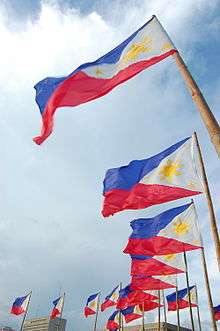
Flag protocol
The flag should be displayed in all government buildings, official residences, public plazas, and schools every day throughout the year. The days of the 28th of May (National Flag Day) and the 12th of June (Independence Day) are designated as flag days, during which all offices, agencies and instrumentalities of government, business establishments, institutions of learning and private homes are enjoined to display the flag.[13] But in recent years, the flag days are now from May 28 to June 30 yearly to promote patriotism and to celebrate the nation's independence.
By law, the Philippine flag must be permanently hoisted and illuminated at night at the following locations:[13]
- Malacañang Palace, the official residence of the President of the Philippines
- Congress of the Philippines buildings:
- Supreme Court of the Philippines building
- Rizal Monument in Luneta, Manila
- Aguinaldo Shrine in Kawit, Cavite
- Barasoain Shrine in Malolos, Bulacan
- Tomb of the Unknown Soldier
- Libingan ng mga Bayani
- Mausoleo de los Veteranos de la Revolución
- All international ports of entry
- All other places as may be designated by the National Historical Institute as such.
Half-mast

The flag may be flown at half-mast as a sign of mourning.[13] Upon the official announcement of the death of the President or a former President, the flag should be flown at half-mast for ten days. The flag should be flown at half-mast for seven days following the death of the Vice President, the Chief Justice, the President of the Senate or the Speaker of the House of Representatives.
The flag may also be required to fly at half-mast upon the death of other persons to be determined by the National Historical Institute, for a period less than seven days. The flag shall be flown at half-mast on all the buildings and places where the decedent was holding office, on the day of death until the day of interment of an incumbent member of the Supreme Court, the Cabinet, the Senate or the House of Representatives, and such other persons as may be determined by the National Historical Institute.
When flown at half-mast, the flag should be first hoisted to the peak for a moment then lowered to the half-mast position. It should be raised to the peak again before it is lowered for the day.
The flag may also be used to cover the caskets of the dead of the military, veterans of previous wars, national artists, and outstanding civilians as determined by the local government. In such cases, the flag must be placed such that the white triangle is at the head and the blue portion covers the right side of the casket. The flag should not be lowered to the grave or allowed to touch the ground, but should be solemnly folded and handed to the heirs of the deceased.
Prohibited acts
.svg.png)
According to Republic Act 8491 itself, it shall be prohibited:[13]
- a) To mutilate, deface, defile, trample on or cast contempt or commit any act or omission casting dishonor or ridicule upon the flag or over its surface;
- b) To dip the flag to any person or object by way of compliment or salute;
- c) To use the flag:
- 1) As a drapery, festoon, tablecloth;
- 2) As covering for ceilings, walls, statues or other objects;
- 3) As a pennant in the hood, side, back and top of motor vehicles;
- 4) As a staff or whip;
- 5) For unveiling monuments or statues; and
- 6) As trademarks, or for industrial, commercial or agricultural labels or designs.
- d) To display the flag:
- 1) Under any painting or picture;
- 2) Horizontally face-up. It shall always be hoisted aloft and be allowed to fall freely;
- 3) Below any platform; or
- 4) In discothèques, cockpits, night and day clubs, casinos, gambling joints and places of vice or where frivolity prevails.
- e) To wear the flag in whole or in part as a costume or uniform;
- f) To add any word, figure, mark, picture, design, drawings, advertisement, or imprint of any nature on the flag;
- g) To print, paint or attach representation of the flag on handkerchiefs, napkins, cushions, and other articles of merchandise;
- h) To display in public any foreign flag, except in embassies and other diplomatic establishments, and in offices of international organizations;
- i) To use, display or be part of any advertisement or infomercial; and
- j) To display the flag in front of buildings or offices occupied by aliens.
The Act mandates that violators shall, upon conviction, be punished by fine or imprisonment.[13]
Pledge
The Pledge of Allegiance to the Philippine flag (distinct from the Patriotic Oath of Allegiance) should be recited while standing with the right hand with palm open raised shoulder high. Individuals whose faith or religious beliefs prohibit them from making such pledge are permitted to excuse themselves, but are required by law to show full respect when the pledge is being rendered by standing at attention.[13]
The law makes no statement regarding the language in which the pledge must be recited, but the pledge is written (and therefore recited) in the Filipino language.
Flag anthem
Spanish, Tagalog and English versions of the national anthem have been given official status throughout Philippine history. However, only the most recent and current "Filipino" version is officially recognised by law. The Flag and Heraldic Code, approved on 12 February 1998 specifies, Lupang Hinirang, "The National Anthem shall always be sung in the national language within or without the country";[13] violation of the law is punishable by a fine and imprisonment .
Similar flags
|
National Flag Day
The National Flag Day in the Philippines is celebrated every 28 May, the very day of the 1898 Battle of Alapan. The official National Flag flying period starts from May 28 and ends on Independence Day, June 12, every year, although the flying period for the flag in homes, businesses and public establishments may start on a specified day of May (to be given by the National Historical Commission of the Philippines) and may last till June 30.
See also
- List of flags of the Philippines
- Flags of the Philippine provinces
- Flags of the Philippine Revolution
- Naval Jack of the Philippines
Notes
- 1 2 3 4 5 6 The eight provinces symbolized by the rays are provinces which had significant early involvement in the Philippine Revolution. Details about the description of the significance of their involvement and the namings of the eight provinces symbolized varies between sources. Sources containing assertions regarding this include the following:
- Lists of provinces
- Batangas, Bulacan, Cavite, Laguna, Manila-Morong, Nueva Ecija, Pampanga, Tarlac.[1]
- Batangas, Bulacan, Cavite, Laguna, Manila, Nueva Ecija, Pampanga, Tarlac.[2][3][4]
- Batangas, Bulacan, Cavite, Laguna, Nueva Ecija, Pampanga, Rizal, Tarlac.[5]
- Batangas, Bulacan, Cavite, Manila, Morong, Nueva Ecija, Laguna, Pampanga.[6][7]
- Bataan, Batangas, Bulacan, Cavite, Laguna, Manila, Nuevo Ecija, Pampanga.[8][9]
- Significance of involvement
References
- 1 2 Lone, Stewart (2007). Daily Lives of Civilians in Wartime Asia: From the Taiping Rebellion to the Vietnam War. Greenwood Publishing Group. p. 50. ISBN 978-0-313-33684-3.
- ↑ Al, Antonio, Et. Side by Side 5' 2002 Ed. Rex Bookstore, Inc. p. 26;. ISBN 978-971-23-3300-2.
- 1 2 Ocampo, Ambeth R. (1993). Aguinaldo's breakfast & more Looking back essays. Anvil Publishing. p. 65. ISBN 978-971-27-0281-5.
- ↑ Benjamin R. Beede (1994). The War of 1898, and U.S. Interventions, 1898–1934: An Encyclopedia. Taylor & Francis. p. 418. ISBN 978-0-8240-5624-7.
- 1 2 Al, Carpio, Et. My Country and My People 5. Rex Bookstore, Inc. p. 139. ISBN 978-971-23-2254-9.
- 1 2 "SYMBOLS OF POWER AND AUTHORITY". House of Representatives of the Republic of the Philippines : 16th Congress, Second Regular Session.
- 1 2 President Emilio Aguinaldo, Acta de la Proclamacion de la Independencia del Pueblo Filipino, Kawit, Cavite: 12 June 1898, "...triángulo blanco como distintivo de la célebre Sociedad "Katipunan" que por medio de pacto de sangre empujó a las masas a insurreccionarse; representando las tres estrellas las tres principales Islas de este Archipiélago, Luzon, Mindanao y Panay en que estalló este movimento insurreccional; indicando el sol los agigantados pasos que han dado los hijos de este país en el camino del progreso y civilización, simbolizando los ocho rayos de aquél las ocho provincias: Manila, Cavite, Bulacan, Pampanga, Nueva Ecija, Bataan, Laguna y Batangas, declarando en estado de guerra apenas se inició la primera insurrección; conmemorando los colores azul, rojo y blanco los de la bandera de los Estados Unidos de la América del Norte, como manifestación de nuestro profundo agradecimiento hacia esta Gran Nación por la desinteresada protección que nos presta y seguirá prestando." , quoted from Design of the Philippine Flag in Symbolisms/Meanings in the Philippine Flag, May 18, 2015, National Commission for Culture and the Arts of the Philippines.
- 1 2 s:Philippine Declaration of Independence
- 1 2 A. P. Samest Blaustein; Jay Adrian Sigler; Benjamin R. Beede (1977). Independence documents of the world. 2. Brill Archive. p. 570. ISBN 0-379-00795-9.
- ↑ Zaide, Sonia M. (1999). The Philippines: A Unique Nation. All-Nations Pub. p. 259. ISBN 978-971-642-071-5.
- ↑ "FULL TEXT: Pres. Benigno Aquino III's Independence Day speech". Sun.Star. June 12, 2015. Retrieved September 23, 2015.
- 1 2 RP flag blooper in New York not intentional—US embassy - INQUIRER.net, Philippine News for Filipinos
- 1 2 3 4 5 6 7 8 9 10 11 12 "Republic Act No. 8491". Government of the Philippines. February 12, 1998. (archived from the original Archived December 5, 2007, at the Wayback Machine. on 2007-12-05).
- ↑ "Executive Order No. 23, s. 1936". www.gov.ph.
- 1 2 "The Philippine National Flag" (PDF). Monuments and Heraldry division, National Historical institute. National Commission for Culture and the Arts.
- ↑ Quezon III, Manuel L. (2002-04-12). "Philippines: the shade of blue". Flags of the World. Archived from the original on 2011-08-18. Retrieved 2007-12-22.
- ↑ "Dictionary of Vexillology:C". Flags of the World. Retrieved 2007-06-06.
- ↑ "Philippines". Vexilla Mundi. Retrieved 2007-06-06.
- ↑ "Executive Order No. 321, s. 1950". Section 1, Paragraph 4.
The Flag, if flown from a flagpole, should have its blue field on top in time of peace and the red field on top in time of war; if in a hanging position, the blue field should be to the right (left of the observer) in time of peace. However, the red should be on the left (of observer) in time of war.
- ↑ "Republic Act No. 8491". Chapter 1, Section 10.
The flag, if flown from a flagpole, shall have its blue field on top in time of peace and the red field on top in time of war; if in a hanging position, the blue field shall be to the right (left of the observer) in rime of peace, and the red field to the right (left of the observer) in time of war.
- ↑ E.A. Baja, Our Country's Flag and Heritage, 1930, Manila, p. 52
- ↑ Manuel Quezon III, 10 November 2002
- ↑ File:EDSAIII.png
- 1 2 3 4 5 6 Quezon, Manuel L. III (2002-04-02). "History of the Philippines Flag". Flags of the World. Archived from the original on 2008-02-05. Retrieved 2007-06-06.
- ↑ Renato Perdon (2010). Footnotes to Philippine History. Universal-Publishers. p. 38. ISBN 978-1-59942-842-0.
- ↑ Augusto de Viana (May 28, 2008). "Where was the Filipino Flag first unfurled?". the Manila Times. Archived from the original on 2008-06-24. Retrieved 2008-05-28.
- ↑ "Want to see PH flag first flown in 1898? Go to Baguio!". Rappler.
- 1 2 "The Declining Reverence for the Philippine Flag". National Historical Commission of the Philippines. Retrieved February 25, 2013..
- ↑ "Today in History". Presidential Museum and Library. 30 October 2013. Retrieved 12 June 2016.
- ↑ "Act No. 1696, s. 1907". Official Gazette of the Republic of the Philippines. Supreme Court Library. 23 August 1907. Retrieved 12 June 2016.
- ↑ "Adjusting the rays of the flag?". Flags of the World. 1998-03-09. Retrieved 2008-06-15.
- ↑ Mallari, Delfin (2003-08-20). "Ople urges putting of Quezon in rays of Philippine flag". Philippine Daily Inquirer. Retrieved 2014-07-23.
- ↑ Michael Lim Ubac, RP flag to have 9th ray to the sun, Philippine Daily Inquirer, September 24, 2009.
- 1 2 Cabreza, Vincent (13 March 2013). "Place for Sabah in flag sought". Retrieved 22 October 2014.
- ↑ Fel V. Maragay (June 11, 1995). "Crescent moon in flag soon?". Manila Standard.
| Wikimedia Commons has media related to Flags of the Philippines. |
External links
- "The Controversial Philippine National Flag". National Historical Institute of the Philippines. May 14, 2008. Archived from the original on 2013-06-18. Retrieved 2008-05-30.
- The Official Website of the Republic of the Philippines
- Philippine at Flags of the World
- Flag and Heraldic Code of the Philippines at Flags of the World
- How to properly display the Philippine flag.
- History of the Philippine Flag:
- Philippines - historical flags of 20th Century, flagspot.net
- Filipino Flag - Learn Now FilipinoFlag.net (archived from the original on 2012-06-23)
- WATAWAT - FLAGS AND SYMBOLS OF THE PEARL OF THE ORIENT SEAS
- History of the Philippine Flag, Philippines Presidential Museum and Library
- Origin of the Symbols of our National Flag, Philippines Presidential Museum and Library
- Flags and Banners of the Colonial Era in the Philippines, Philippines Presidential Museum and Library




